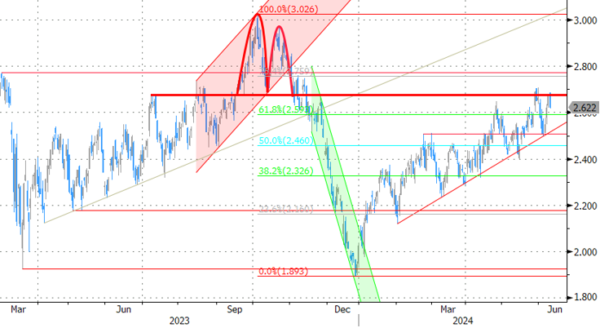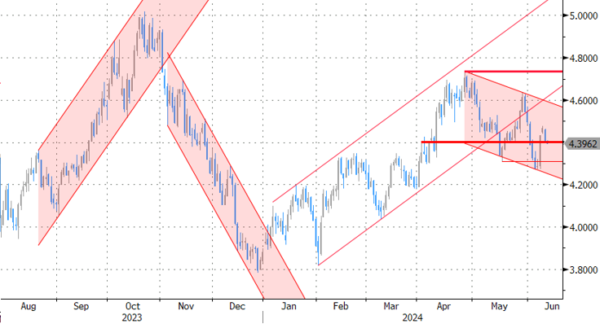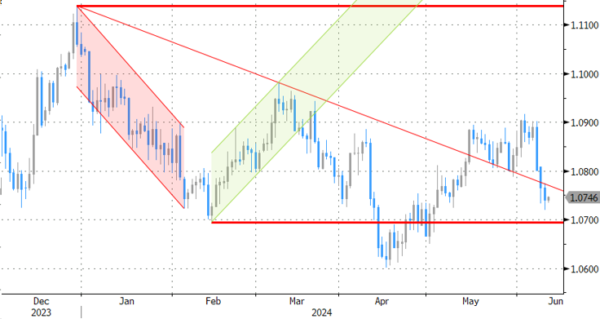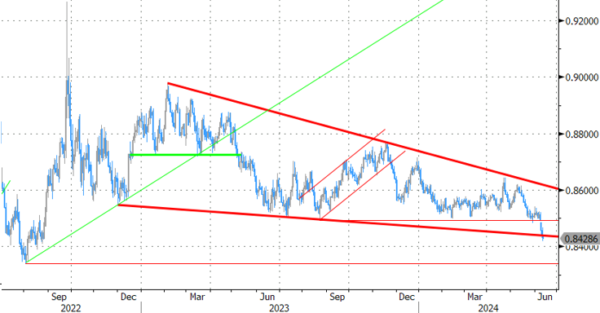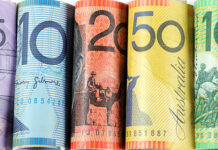Markets
Market conditions remained sour yesterday. Macron’s political gamble got another layer of uncertainty on rumours that the French president would resign in case of a defeat in the snap elections. While denied later, the genie was out of the bottle. Stocks in Europe remained under pressure. It wasn’t France’s CAC40 (-1.33%) that underperformed this time around, but Borsa Italiana (-1.93%), suggesting spreading market concerns. Both countries as well as Greece saw credit risk premia rising again (both against swap and Germany’s 10-yr) yield). The French spread vs swaps built on Monday’s break above the 2020 high. German bunds attracted a safe haven bid with yields easing between 2 (30-yr) and 6.6 bps (2-yr). US yields traded only a tad lower going into a strong $39bn 10-yr auction which stopped through (4.438% vs 4.458% WI). Bidding metrics were strong with the highest bid-to-cover in more than two years and investors snapping up about 75% of the sale, the most for a 10-yr auction since February 2023. The results contrasted sharply with those for the 3-yr auction on Monday and pushed rates in the US 4.5 to 6.4 bps lower across the curve. Euro weakness prevailed in currency markets. EUR/USD dropped for a third day straight to the lowest since early May (1.074). Some dollar strength was at play too. DXY moved further north of the 105 barrier. EUR/GBP quickly reversed a kneejerk move higher in the wake of the British labour market report to finish at a new YtD low of 0.8418.
The US is in the spotlights today. Tonight’s FOMC meeting is preceded by important CPI numbers. We see upside risks for the headline number (0.1% m/m, 3.4% y/y) and are more neutral on the core reading (0.3%, 3.5%). It serves as some last-minute input for the Fed even though it probably won’t have been factored in into the new projections. The policy rate will remain at an unchanged 5.25-5.5%, directing market’s focus towards the median rate forecasts. The March dot plot projected three rate cuts but that was a close call. We expect that balance to have shifted to two while holding on to the three forecasted for 2025. Markets currently already discount such a combined five cuts and differ only on the timing. In any case, the market reaction may stay muted. Projecting only one cut for 2024 without moving the second to 2025 is a tail risk that may trigger a UST sell-off. It does, however, require a large shift in individual views. We’ll keep a close eye at the long-term projection for the neutral rate, which is likely to have shifted further north. The statement in May adjust to the hawkish side, citing lack of progress towards the 2% inflation target. Eco data since offer few reasons to turn outright dovish with the latest services ISM and payrolls report case in point. But a more balanced tone from chair Powell (e.g. stressing the downturn in manufacturing or the uptick in the unemployment rate) at the presser should even things out a bit. Still, combined with the CPI release we’re more biased towards higher core/US yields. The dollar’s fortunes are at least, if not more, determined by the euro.
News & Views
Bloomberg reports that the US government is considering further restrictions on China’s access to chip technology used for AI, according to people close to the matter. Topic of debate is limiting the ability to use “gate all-around”, a new chip architecture which will be part of the next generation semiconductors to be manufactured withing the next year. There are also early-stage talks about limiting exports of high-bandwidth memory chips, used to train AI software. US Commerce Secretary Raimondo at several occasions stressed that the US will add to existing restrictions as much as needed to keep the most advanced AI technology out of Chinese hands.
Chinese inflation fell by 0.1% M/M on a headline level and by 0.2% M/M for the underlying core series. Both reversed similar increases in April. Consumer goods prices fell for a third month straight with services prices falling into deflation as well in May. Weak consumer demand remains the key reason. In Y/Y-terms, headline and core inflation respectively remained unchanged at 0.3% and slowed from 0.7% to 0.6%. Producer prices recorded a 20th consecutive Y/Y-decline, with the pace slowing though from -2.5% in April to -1.4% in May.
Graphs
GE 10y yield
The ECB cut its key policy rates by 25 bps at the June policy meeting. A more bumpy inflation path in H2 2024, the EMU economy gradually regaining traction and the Fed’s higher for longer US strategy make follow-up moves difficult. Markets are coming to terms with that. The German 10y yield set a new YtD top at 2.7%.
US 10y yield
The Fed in May acknowledged the lack of progress towards the 2% inflation objective, but Fed Chair Powell indicated that further tightening was unlikely. However, the FOMC Minutes still showed internal debate on whether policy is restrictive enough. Sticky inflation suggests any rate cut will be a tough balancing act while several policy makers hint at a higher neutral rate. The US 10-y yield is stuck in the 4.3/4.7% trading range.
EUR/USD
EUR/USD is stuck in the 1.06-1.09 range. The desynchronized rate cut cycle with the ECB exceptionally taking the lead, strong US May payrolls and a swing to the right in European elections pulled the pair away from 1.09 resistance. Focus turns to the US side of the story with May CPI inflation numbers and a more hawkish Fed looming on the horizon.
EUR/GBP
Debate at the Bank of England is focused at the timing of rate cuts. Slower than expected April disinflation and a surprise general election on July 4 suggest that a June cut in line with the ECB looks improbable. Sterling gained momentum with money markets now discounting a Fed-like scenario. EUR/GBP tested the 2023 & 2024 lows near 0.85. Euro weakness eventually pulled the trick after French president Macron called snap elections following a weak showing in EU elections.




